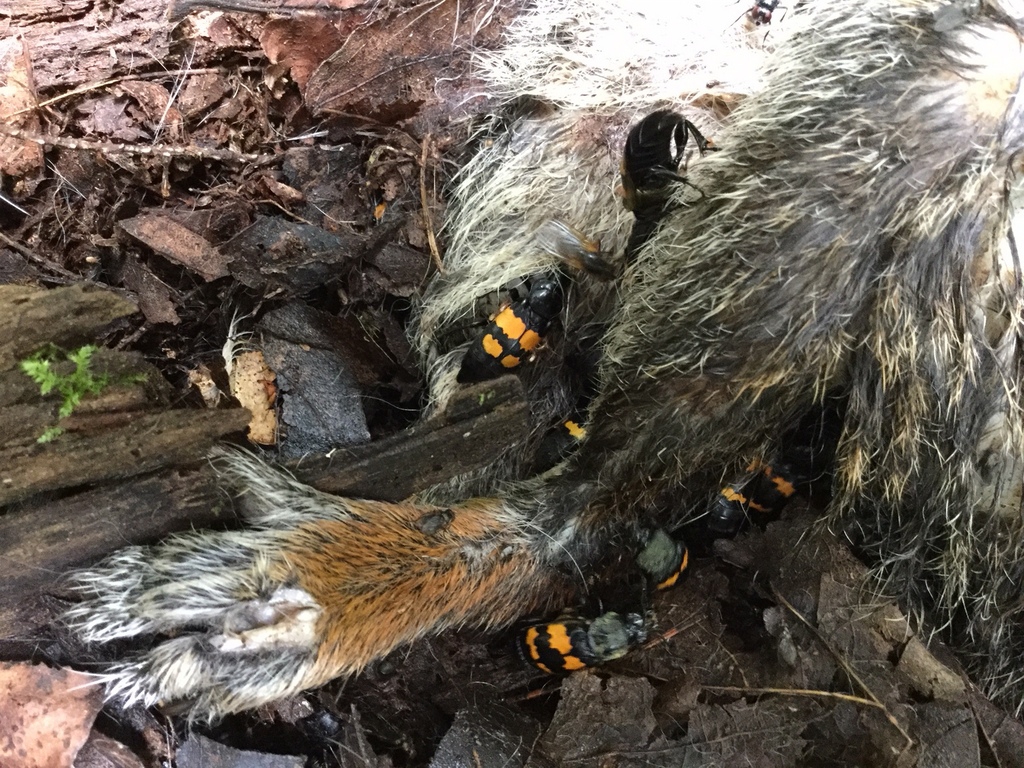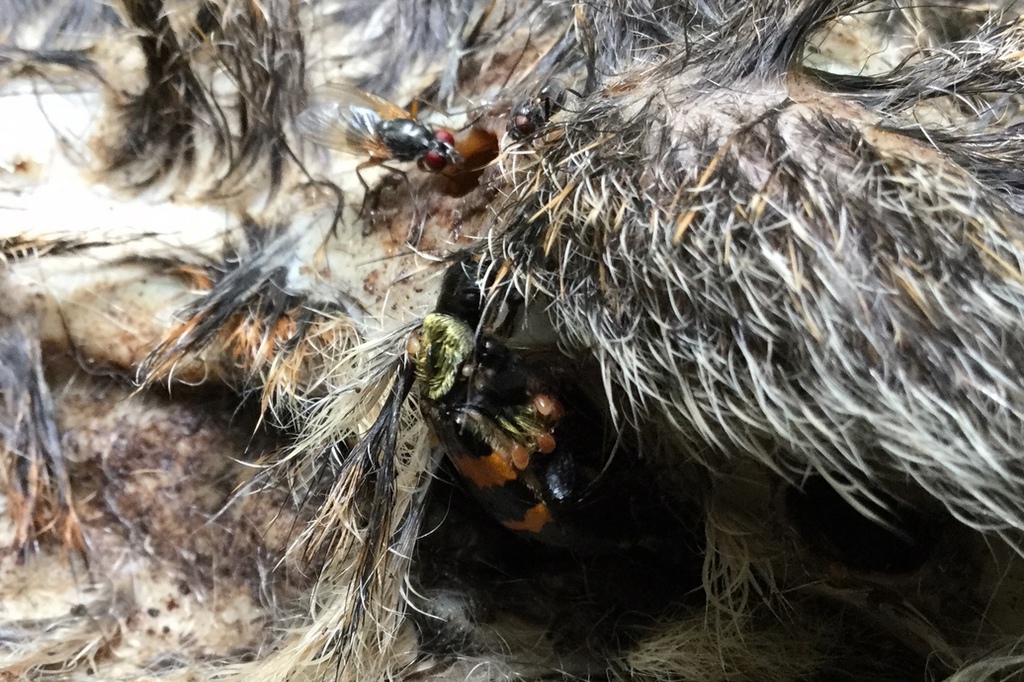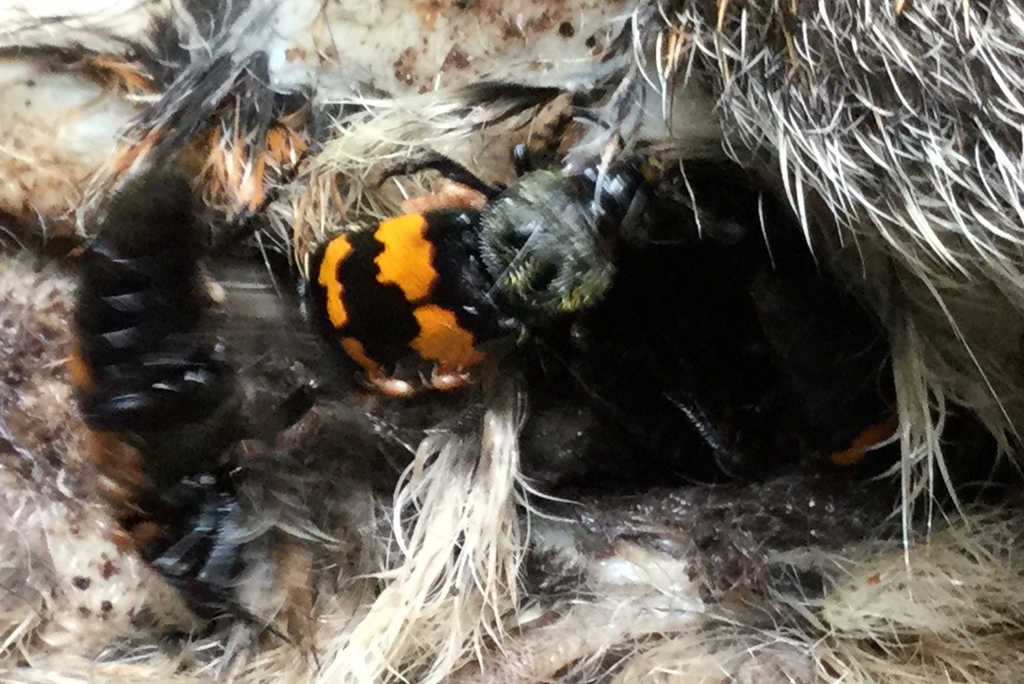
Gold-neck carrion beetles scavenging a gray squirrel carcass (Richmond, VT)
Care for the young and eat the old
It’s a hot day and the heat seams to both stir up and trap the smells of the forest. A particular scent catches on the dull air and hangs thick next to a creek that runs by my mom’s house in Richmond. It’s the smell of an animal coming to terms with its mortality. After an animal dies it immediately begins to decompose. Our noses twitch and scrunch at the detection of a rotting carcass, responding primarily to the chemicals hydrogen sulfide, cadaverine and putrescine, which begin to concentrate rather quickly as amino acids begin to break down. These chemicals smell foul to us because this indicates that it’s probably not a great health choice to consume rotting meat (similar to why feces and urine, which are toxic to us, also smell bad).
However, to scavengers and necrophagous (eaters of the dead) species, these chemicals don’t smell bad and in fact indicate the availability of food. Necrovores need highly sensitive equipment for detecting limited resources (dead and decomposing things) that are scattered randomly across the landscape exceptionally difficult. In the Silphidae, the carrion beetle family, antennae are modified with clubs for detecting odors from carcasses from up to several kilometers away (link).

A unknown species of fly competing with a gold-neck carrion beetle for the carcass of a gray squirrel (Richmond, VT)
Nicrophorus tomentosus
One of our more common carrion beetles is the gold-necked carrion beetle (or what I call the Charlie Brown beetle). They’re a medium sized, black beetle with 2 orange zig-zag lines along their backs (like an inverted Charlie Brown shirt) and a golden fuzz-covered neck. In the warmer months (May – October), these little critters are one of the first on the scene to small dead mammals like shrews and voles, competing directly with flies and ants for this limited resource. To monopolize the dead animal, the beetles will drag and then bury smaller carcasses underground (for smaller animals, a male-female pair will monopolize the resource together). They then actively defend the carcass from other necrovores and defend their brood as their young ‘uns devour the carcass. They’re one of the only insects that exhibit biparental care!
I’ve found shrews and voles actively being buried and at first they usually look like this monstrous zombies grotesquely writhing on the ground. The beetles dig out the soil from underneath and so often you don’t see the beetle, just the strange motions of the body being buried. It’s only slightly less disconcerting to see the beetles emerge from beneath. With larger carcasses, like the gray squirrel my sister and I found, several pairs of beetles will collectively eat the carcass and raise young (research). On the carcass we found, there were probably around 15-20 individual beetles frantically working the carcass and only a few flies competing with them. The carcass had been about 80% consumed in less than a couple days (Meryl had already come across the carcass the day before).

Gold-neck carrion beetle with phoretic mites attached to its back (Richmond, VT)
Phoretic mites
Many of the beetles had little red dots on their bodies (visible in the video). They looked similar to varroa mites that parasitize honey bees. I couldn’t get a good look at them, but found some research indicating that these are likely phoretic mites (phoretic just means that they’re transported by the host but not otherwise parasitic). The mites hitch rides on the beetles from corpse to corpse and once arrived hop down off their backs to scavenge around for fly eggs. The more eggs they consume the less competition the beetles have for the carcass. Incredible.



